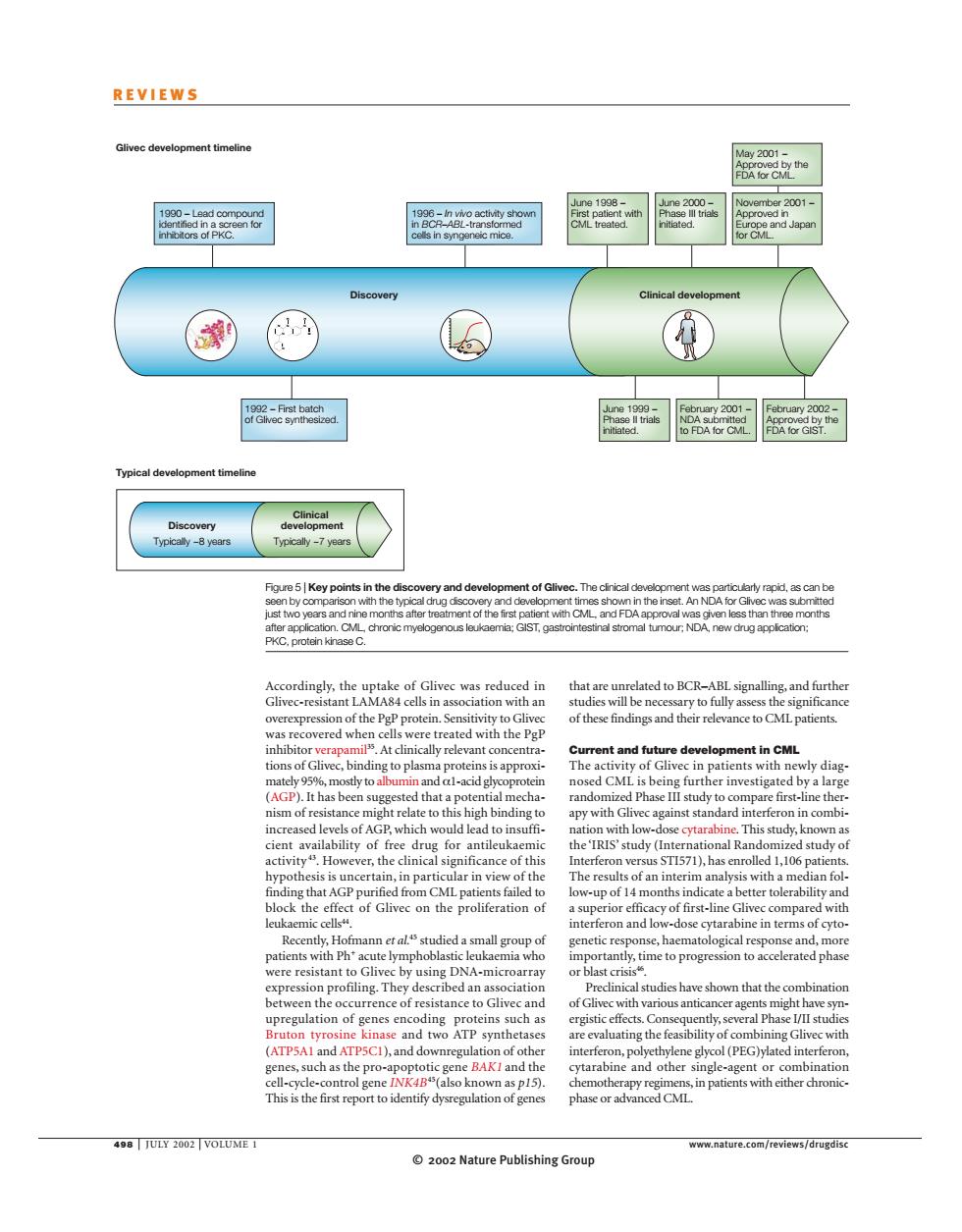正在加载图片...

REVIEWS Clinical deve 二 Typical dev ent tin very Typically-8 years .chronic mvelooenous le tha ary to fully assess the the ot these of Glivec,bin rly dias AGP).It has beer increased levels of AGB which would lead to insuffi with low- ose cytarabin This study,kno IS'study).ha nding that AGP p m CMLpa ts failed to of l th te a bet the cl Glivec on the proliferation of e,h The shown that the of G nous ant aluating the wit arabine and other singl This is the first report to identify dysregulation of genes phase or ad 9 JULY2002 VOLUM正1 2002 Nature Publishing Group © 2002 Nature Publishing Group 498 | JULY 2002 | VOLUME 1 www.nature.com/reviews/drugdisc REVIEWS that are unrelated to BCR–ABL signalling, and further studies will be necessary to fully assess the significance of these findings and their relevance to CML patients. Current and future development in CML The activity of Glivec in patients with newly diagnosed CML is being further investigated by a large randomized Phase III study to compare first-line therapy with Glivec against standard interferon in combination with low-dose cytarabine. This study, known as the ‘IRIS’ study (International Randomized study of Interferon versus STI571), has enrolled 1,106 patients. The results of an interim analysis with a median follow-up of 14 months indicate a better tolerability and a superior efficacy of first-line Glivec compared with interferon and low-dose cytarabine in terms of cytogenetic response, haematological response and, more importantly, time to progression to accelerated phase or blast crisis46. Preclinical studies have shown that the combination of Glivec with various anticancer agents might have synergistic effects. Consequently, several Phase I/II studies are evaluating the feasibility of combining Glivec with interferon, polyethylene glycol (PEG)ylated interferon, cytarabine and other single-agent or combination chemotherapy regimens, in patients with either chronicphase or advanced CML. Accordingly, the uptake of Glivec was reduced in Glivec-resistant LAMA84 cells in association with an overexpression of the PgP protein. Sensitivity to Glivec was recovered when cells were treated with the PgP inhibitor verapamil35. At clinically relevant concentrations of Glivec, binding to plasma proteins is approximately 95%, mostly to albumin and α1-acid glycoprotein (AGP). It has been suggested that a potential mechanism of resistance might relate to this high binding to increased levels of AGP, which would lead to insufficient availability of free drug for antileukaemic activity 43. However, the clinical significance of this hypothesis is uncertain, in particular in view of the finding that AGP purified from CML patients failed to block the effect of Glivec on the proliferation of leukaemic cells44. Recently, Hofmann et al.45 studied a small group of patients with Ph+ acute lymphoblastic leukaemia who were resistant to Glivec by using DNA-microarray expression profiling. They described an association between the occurrence of resistance to Glivec and upregulation of genes encoding proteins such as Bruton tyrosine kinase and two ATP synthetases (ATP5A1 and ATP5C1), and downregulation of other genes, such as the pro-apoptotic gene BAK1 and the cell-cycle-control gene INK4B45(also known as p15). This is the first report to identify dysregulation of genes June 1998 – First patient with CML treated. 1990 – Lead compound identified in a screen for inhibitors of PKC. 1996 – In vivo activity shown in BCR–ABL-transformed cells in syngeneic mice. June 2000 – Phase III trials initiated. November 2001 – Approved in Europe and Japan for CML. May 2001 – Approved by the FDA for CML. June 1999 – Phase II trials initiated. 1992 – First batch of Glivec synthesized. February 2001 – NDA submitted to FDA for CML. February 2002 – Approved by the FDA for GIST. Discovery Clinical development N N N N H H N O Discovery Clinical development Typically ~8 years Typically ~7 years Typical development timeline Glivec development timeline Figure 5 | Key points in the discovery and development of Glivec. The clinical development was particularly rapid, as can be seen by comparison with the typical drug discovery and development times shown in the inset. An NDA for Glivec was submitted just two years and nine months after treatment of the first patient with CML, and FDA approval was given less than three months after application. CML, chronic myelogenous leukaemia; GIST, gastrointestinal stromal tumour; NDA, new drug application; PKC, protein kinase C